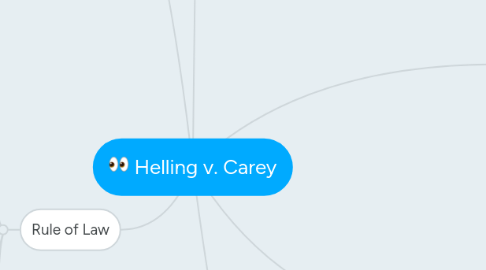
1. Issue
1.1. The issue stems from whether or not the defendants, Carey and Laughlin, operated within the standards of practice in their field
1.1.1. The Standard of does not call for an ocular pressure tests for persons under 40 years of age
2. Rule of Law
2.1. Medical Negligence
2.1.1. Duty
2.1.1.1. A physician-patient relationship must exist
2.1.2. Breach
2.1.2.1. A breach of duty occurs when the defendant fails to exercise reasonable care for a specified duty - which is determined by the jury through a question of facts
2.1.2.2. The plaintiff must show that the standard of care was breached by presenting evidence of facts and expert testimony that would attest to this standard of care
2.1.2.3. The expert must be within the same school of thought or practice as the defendants or have substantial knowledge about the area
2.1.3. Causation
2.1.3.1. the plaintiff must prove that the defendant's action caused the injury in question
2.1.3.2. 1. The injury would not have occurred but for the defendant's acts
2.1.3.3. 2. it was a foreseeable result of the negligent act
2.1.3.4. Proximate Cause: were the injuries foreseeable and were the actions by the defendant directly contributory to the plaintiff's injury?
2.1.4. Damages
2.1.4.1. Was there a legally recognized harm due to the negligence by the defendant?
2.2. Reasonable prudence
2.2.1. requires a standard of care higher than the ones customarily and locally accepted by the ophthalmologist community regarding glaucoma screening
2.2.2. There must have been a reason to have ophthalmologists practice outside the standard
2.3. Strict Liability
2.3.1. Plaintiff would need to prove that the defendant was responsible her injuries, even if the defendant acted in good faith or took all necessary precautions
3. Facts
3.1. Barbara Helling the plaintiff suffered from open angle glaucoma
3.1.1. Drs. Thomas Carey and Robert Laughlin were co-defendants and Helling's ophthalmologists
3.1.1.1. Helling soon filed a malpractice lawsuit stating that the Co-defendant's negligence contributed to the vision loss
3.1.1.1.1. the standards of practice does not require persons under 40 years of age to undergo a pressure test due to the rare nature in this particular age group
3.2. The condition led to a rise in ocular pressure, which eventually led to optic nerve damage and eventually a loss of vision
3.2.1. Helling initially thought that her issueswere a result of irritation from contact lenses
3.2.1.1. a few years later Dr. Carey performed an eye and field of vision test
3.2.1.1.1. Helling claimed the defendants failed to conduct her pressure test timely which caused her permanent vision loss
3.2.1.2. The eye test revealed that Helling had developed glaucoma, which contributed to some of her vision loss
4. Application
4.1. plaintiff must prove that there was a violation or breach of Standards of Care
4.2. Plaintiff Arguments
4.3. physician-patient relationship exists
4.4. The patient argues that not enough was done to "look into" the eye discomfort she suffered for 9 years
4.5. A tonometry test would have shown that she had developed a glucaoma
4.6. Even though it was not in the usual "standard of care" for patients under 40 years of age, there should be consideration and they could have made an exception to her case
4.7. Outside the standard of care to test a woman under 40 for glaucoma.
4.8. It goes against evidence-based practice and the nationally guidelines accepted by the community of ophthalmologists
4.9. Working outside standard of care is time and money potentially wasted for unnecessary testing in other patients
4.10. Causation
4.10.1. The plaintiff may argue that there was a proximate cause that linked her developing glaucoma and permanent vision loss with the doctor's negligence to look further into it. Them failing to diagnose her, substantially contributed to permanent damage
4.10.2. The plaintiff may also argue that she could have been referred to by another opthalmologist for a second opinion
4.10.3. the plaintiff could have sought a 2nd and 3rd opinion, however Dr Carey was her primary care and could have referred her if he could not provide utmost care
5. Conclusion
5.1. The supreme court reversed the judgement for the defendants, Carey and Laughlin due to reasonable prudence standards - which required the doctors to perform that test even though the standards of practice does not call for it
6. Impact
6.1. Statute passed in Washington that would attempt to overturn the Helling rule
6.1.1. Cautionary tale of what can occur if medical professionals only go by science alone. Medical professionals must rely on instinct in addition to the science and theory of medical practice
6.2. Gates v Jensen
6.2.1. Held that the Helling's rule was still in effect and that the "standard was not limited to what the members of the profession did, but what they ought to have done"
6.3. Practices influenced
6.3.1. Medical Malpractice Lawsuits
6.3.1.1. Due to potential lawsuits, practitioners may order additional tests that may otherwise deviate from the normal standard of care for a particular condition.
6.3.2. 2. Ophthalmologists deviating from normal practice patterns to quickly diagnose conditions
6.3.2.1. This increases cost of care but will not reduce negative outcomes
